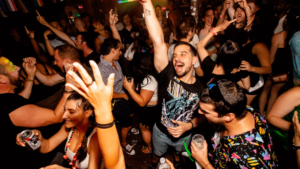This is a guest post from Matt Banner, the Founder of OnBlastBlog.com, where they put proven & practical strategies to the test to help you blast off your blog.
Each year, the field of digital marketing and event management changes in countless different ways. New trends come, old ones go, and as marketers we’re left with no choice but to keep up. As 2017 continues to progress, some of the old trends will solidify, while others will become more important than ever before.
There may even be a few surprises as well. That’s why we’re taking a look at five big trends happening in digital marketing throughout 2017, and how you can start preparing your strategies to meet them head on.
5 Digital Marketing Trends Event Planners Need to Know in 2017
Digital marketing is no longer something that’s entirely reserved for the online world. Technology has made it so the physical and digital planes are tightly woven together. What affects one, affects the other, and in many cases we’re seeing how live events can tie directly into your digital marketing and vice versa.
Here are five trends happening in 2017 that you should prepare for today.
1. Live streaming takes priority
New events and experiential companies have a pretty standard procedure in today’s digitally-focused world. They immediately work on establishing an online presence, including how to start a blog in 2017, so they can start building their brand.
Today’s companies have followed this path and its lead them towards a strong foundation for their digital marketing and their events. Having a strong brand is something that should always be in the forefront of an event organiser’s mind.
A new trend has now arrived to add another layer to the proceedings. Many companies are using the plethora of live streaming tools at their disposal to create events that happen simultaneously in the physical and digital space.
The most popular option, of course, is Facebook Live. One of my favourite examples of this trend at work, was the broadcast that Tough Mudder did for one of their events. They were having an event where a lot of people in their audience couldn’t be present. So, to bring them into the fold, they streamed the event live.
During this time, Coach T. Mud, the face of the brand, seamlessly engaged with people both in front of him and online. During his instructions or interviewers, he would casually mention products or training opportunities to the virtual audience, thus keeping them engaged throughout.
He also cross-promoted the brand’s Snapchat channel, thus raising awareness of their other marketing channels. This was unique when they did it, but now, in 2017, it’s something every event planner should be considering. The potential for reach in the digital space is too much to pass up.
Here’s how you start utilising this trend:
- Facebook Live is easy to use, and it’s totally free
- You can start streaming at any time, but savvy organizers will promote the stream prior to the event
- Include promotion of the stream on your marketing materials for the actual event and encourage people to use a hashtag when engaging your brand online
2. Events are just the beginning
Experiential marketing is a big buzzword right now, and it won’t be going anywhere in 2017. The concept of creating an experience for your attendees and your customers is the next step in the evolution of digital marketing.
To that end, events won’t be the end of your campaigns in 2017. Instead, events will become the foundation for your digital campaigns. They will act as the first impression, but they will be followed by continued engagement, follow-ups, and connected campaigns from blogs to email, webinars to social media.
The best way to think of it is to stop treating events like a separate tool and instead recognise how they fit into the larger puzzle that is your marketing campaign.
Here are some ways to prepare for this now:
- By using tools like social media, email and your blog, you can engage people outside the event, and start conversations that last long after the doors close.
- Incorporate engaging materials into your campaign once the event has ended. Share pictures from that day on Instagram and Pinterest. Ask people to share their thoughts on Twitter and Facebook. Continue to engage them and use the event as a launch pad for that conversation.
3. Virtual Reality expands your reach
Virtual reality, or VR as it is commonly known, is an exciting new technology that is changing how we think about marketing. In many cases, you’ll hear about video games that utilise the technology, but the experience that it facilitates can translate very easily to experiential marketing and events.
For example, one digital marketing firm uses VR to show potential customers what a wedding would look like at various luxury venues. Instead of touring an empty room or travelling all over, customers are transported into a wedding that’s happening all around them, without leaving the room.
It’s an experience that transcends everything we know about marketing and offers huge potential for bringing consumers into an experience that they won’t soon forget. Even Facebook has seen the potential in this technology, with a purchase of the VR company Oculus Rift for $2 billion.
Now, the obstacle right now is that VR is expensive for the average consumer, and it’s not widespread, yet. Even so, companies can treat customers to an unforgettable experience with one single headset if they hold events or private meetings where they can provide a VR headset to facilitate their experience.
How to start thinking about this now:
- Consider the experiences you provide for customers at your events. How can these be replicated or enhanced with VR?
- Look at the technology and find out which option could work with your budget. For example, Samsung VR only requires a $100 headset and a compatible phone.
4. Big Data leads to big decisions
When we break down the concept of big data, it involves three V’s:
- Volume
- Velocity
- Variety
Take a look at this graph illustrating the concept:

Volume represents the amount of data, while velocity measures the speed of growth and change, and finally variety represents the types of data. Marketers have always known the inherent value of big data, but in 2017 this type of information is going to be combined with other emerging technologies to fuel some of the biggest decisions you and your company will make.
For example, this data can be used to create more powerful analytics. Combined with machine learning algorithms, big data can be used to understand the how’s and the why’s behind consumers in a given audience.
This, in turn, fuels automation by giving you the ability to make informed decisions quickly and decisively. You’ll know exactly how to structure your advertising or when/where to plan your event based on the intense analysis of these huge volumes of data.
For example, by connecting your Eventbrite page to Facebook using our simple integration, you can run campaigns that promote your event to people who have visited your site but not booked (called retargeting); or even run promotional campaigns that target potential attendees who are similar to those that have already bought a ticket (thanks to the power of big data and algorithms).
What this means for your marketing, today:
- Start expanding your reach of data and use it to inform your personalisation and digital marketing strategies
- Look into Facebook retargeting to convert visitors into paying attendees (or find new audiences to expand your reach)
- Continue learning and growing by utilising predictive analytics to put data into action
5. Mobile is a Requirement, Not an Option
Mobile devices have steadily been growing and becoming more prevalent, but in 2017 they have crossed the line between optional and required for your marketing strategy. You’ll need to optimise your website and blog for mobile, but you’ll also need to go further than that, and make mobile a priority in your whole event’s strategy.
Beyond structuring your content for mobile, you should also consider the behaviours and needs of mobile users. Among other things, they include the following:
- Speed
- Accessibility
- Readability
Since mobile users consume content on-the-go, this alone requires that you structure your content so it’s easily digestible, and this is just scratching the surface of a mobile-focused strategy.
If you have any doubts about mobile as a requirement in your 2017 strategies, consider these statistics:
- 80% of internet users own a smartphone
- Over 50% of users grab their smartphone immediately when they wake up
- 71% of marketers believe that mobile marketing is core to their business
Final Thoughts
Digital marketing is changing once again in 2017, but event organisers can start planning their new strategies now and be ready when the time comes to implement these new best practices. What trends do you see emerging in 2017? Let us know in the comments!





